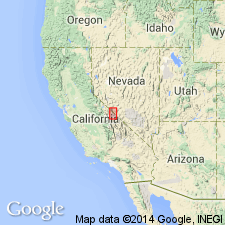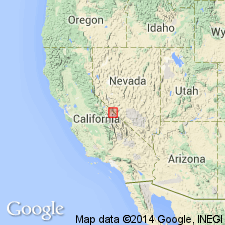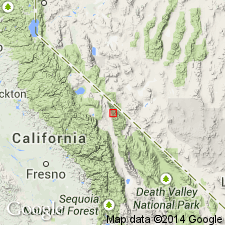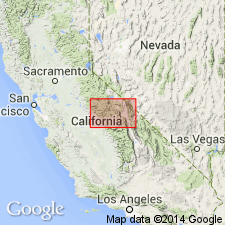
- Usage in publication:
-
- Pellisier Flats pluton
- Modifications:
-
- Not used
- Geochronologic dating
- AAPG geologic province:
-
- Sierra Nevada province
Summary:
K-Ar determinations on hornblende from Pellisier Flats pluton yielded 98.0 +/-3 and 89.7 +/-3 Ma. Age is considered uncertain because minerals appear as irregular, splotchy intergrowths of biotite and hornblendes suggestive of recrystallization. Petrographic similarities with Mount Barcroft unit suggest possibility that Pellisier Flats pluton may be as old as Triassic.
Source: GNU records (USGS DDS-6; Menlo GNULEX).

- Usage in publication:
-
- Pellisier Flats unit*
- Modifications:
-
- First used
- Dominant lithology:
-
- Granite
- Quartz monzonite
- AAPG geologic province:
-
- Sierra Nevada province
Summary:
Term "Pellisier Granite" was first used by Anderson (1937) and included rocks on east side of range that Emerson (1966) and Krauskopf (1971) later found to be separate masses in Mt. Barcroft 15' quad. Terms "quartz monzonite and granite of Pellisier Flats" or 'Pellisier Flats unit" used in this report. Shown on geologic sketch map of northern White Mountains. Detailed petrographic and chemical analyses included in report. Pellisier Flats unit is probably Triassic or Jurassic age.
Source: GNU records (USGS DDS-6; Menlo GNULEX).

- Usage in publication:
-
- Pellisier Flats Granite
- Modifications:
-
- Named
- Dominant lithology:
-
- Granite
- AAPG geologic province:
-
- Sierra Nevada province
Summary:
[Authors use name Pellisier Flats Granite evidently referring to "Pellisier Flats unit" of Krauskopf (1971) and "adamellite and granite of Pellisier Flats" of Crowder and Sheridan (1972) cited in their geologic sketch map.] Pellisier Granite apparently intruded after D2 (second phase of Mesozoic) deformation. Age is shown as Cretaceous on geologic sketch map.
Source: GNU records (USGS DDS-6; Menlo GNULEX).

- Usage in publication:
-
- granite of Pellisier Flats
- Modifications:
-
- Not used
- Geochronologic dating
- AAPG geologic province:
-
- Sierra Nevada province
Summary:
Discordant U-Pb age of 90 Ma (Stern and others, 1981) has been reported. Age of granite of Pellisier Flats remains in doubt. Assigned mid-Cretaceous(?) age in explanation of map units.
Source: GNU records (USGS DDS-6; Menlo GNULEX).
For more information, please contact Nancy Stamm, Geologic Names Committee Secretary.
Asterisk (*) indicates published by U.S. Geological Survey authors.
"No current usage" (†) implies that a name has been abandoned or has fallen into disuse. Former usage and, if known, replacement name given in parentheses ( ).
Slash (/) indicates name conflicts with nomenclatural guidelines (CSN, 1933; ACSN, 1961, 1970; NACSN, 1983, 2005, 2021). May be explained within brackets ([ ]).

